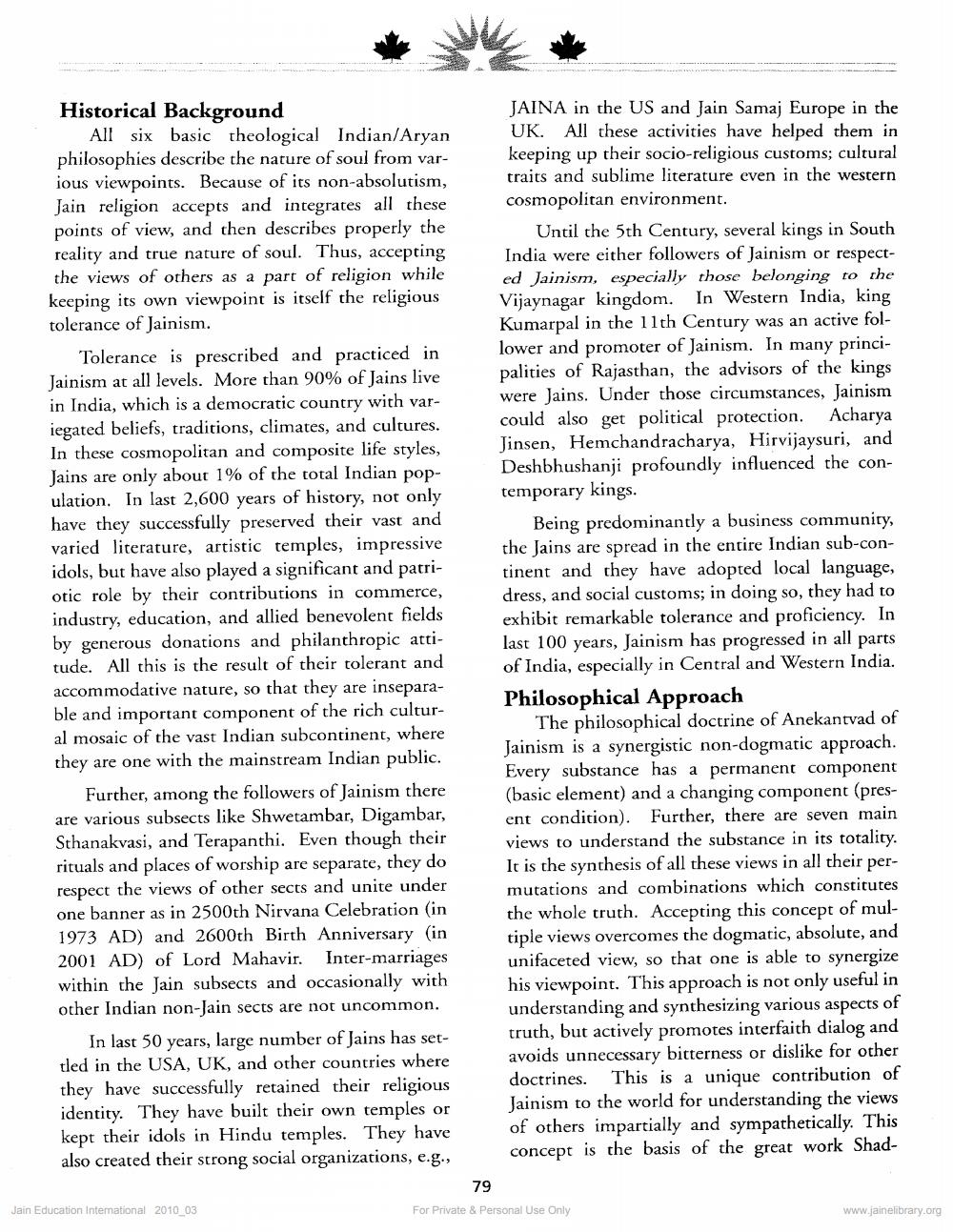________________
Historical Background
All six basic theological Indian/Aryan philosophies describe the nature of soul from various viewpoints. Because of its non-absolutism, Jain religion accepts and integrates all these points of view, and then describes properly the reality and true nature of soul. Thus, accepting the views of others as a part of religion while keeping its own viewpoint is itself the religious tolerance of Jainism.
Tolerance is prescribed and practiced in Jainism at all levels. More than 90% of Jains live in India, which is a democratic country with variegated beliefs, traditions, climates, and cultures. In these cosmopolitan and composite life styles, Jains are only about 1% of the total Indian population. In last 2,600 years of history, not only have they successfully preserved their vast and varied literature, artistic temples, impressive idols, but have also played a significant and patriotic role by their contributions in commerce, industry, education, and allied benevolent fields by generous donations and philanthropic attitude. All this is the result of their tolerant and accommodative nature, so that they are inseparable and important component of the rich cultural mosaic of the vast Indian subcontinent, where they are one with the mainstream Indian public.
Further, among the followers of Jainism there are various subsects like Shwetambar, Digambar, Sthanakvasi, and Terapanthi. Even though their rituals and places of worship are separate, they do respect the views of other sects and unite under one banner as in 2500th Nirvana Celebration (in 1973 AD) and 2600th Birth Anniversary in 2001 AD) of Lord Mahavir. Inter-marriages within the Jain subsects and occasionally with other Indian non-Jain sects are not uncommon.
In last 50 years, large number of Jains has settled in the USA, UK, and other countries where they have successfully retained their religious identity. They have built their own temples or kept their idols in Hindu temples. They have also created their strong social organizations, e.g.,
JAINA in the US and Jain Samaj Europe in the UK. All these activities have helped them in keeping up their socio-religious customs; cultural traits and sublime literature even in the western cosmopolitan environment.
Until the 5th Century, several kings in South India were either followers of Jainism or respected Jainism, especially those belonging to the Vijaynagar kingdom. In Western India, king Kumarpal in the 11th Century was an active follower and promoter of Jainism. In many principalities of Rajasthan, the advisors of the kings were Jains. Under those circumstances, Jainism could also get political protection. Acharya Jinsen, Hemchandracharya, Hirvijaysuri, and Deshbhushanji profoundly influenced the contemporary kings.
Being predominantly a business community, the Jains are spread in the entire Indian sub-continent and they have adopted local language, dress, and social customs; in doing so, they had to exhibit remarkable tolerance and proficiency. In last 100 years, Jainism has progressed in all parts of India, especially in Central and Western India. Philosophical Approach
The philosophical doctrine of Anekantvad of Jainism is a synergistic non-dogmatic approach. Every substance has a permanent component (basic element) and a changing component (present condition). Further, there are seven main views to understand the substance in its totality. It is the synthesis of all these views in all their permutations and combinations which constitutes the whole truth. Accepting this concept of multiple views overcomes the dogmatic, absolute, and unifaceted view, so that one is able to synergize his viewpoint. This approach is not only useful in understanding and synthesizing various aspects of truth, but actively promotes interfaith dialog and avoids unnecessary bitterness or dislike for other doctrines. This is a unique contribution of Jainism to the world for understanding the views of others impartially and sympathetically. This concept is the basis of the great work Shad
79
Jain Education International 2010_03
For Private & Personal Use Only
www.jainelibrary.org




